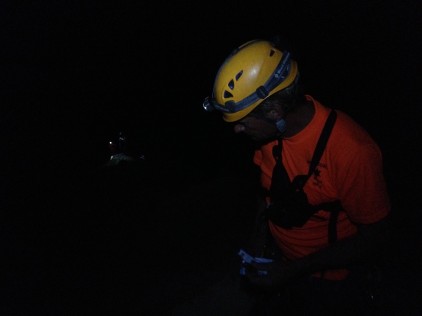On Friday, April 18th at 7:30pm Inyo SAR members received notice of a young woman trapped on a cliff in Death Valley National Park’s Golden Canyon. Golden Canyon is best known for its appearance in Star Wars when R2D2 gets ambushed by Jawa. In fact, it appears that we used the very same narrow corridor/gully where the Jawa were hiding in the movie to access the terrain above our patient. Neato.
We arrived on scene with five very capable Inyo SAR members (one WEMT, one EMT, and three WFRs, all with technical rope experience) at approximately 12:30am and were met by three DVNP rangers and an ALS ambulance. They had been working on this rescue since approximately 4:30pm and briefed us on the situation.
During the afternoon of the 18th, our patient (PT) along with her partner and their two young children decided to explore a narrow side canyon near the entrance to Golden Canyon. After making their way fairly high up the continuously sloughing chute, the kids became weary and were brought back to the car by her partner. She decided to continue exploring alone. When she began to make her way back to her family, she accidentally began descending the wrong gully, quickly becoming unable to safely descend or ascend.
DVNP rangers were alerted and began rescue efforts. One ranger was able to get above the PT with anchor gear and a rope, but because of the convoluted terrain combined with the HORRIBLE rock quality, she was unable to orient herself and her rope correctly in relation to the PT for a safe pick-off. To make matters more complicated, she could see that a standard length rope (~200′) was not going to be long enough…and it was getting dark. After this valiant but unsuccessful first effort, Inyo SAR was called to assist.
We began by making visual and audio contact with the PT at approximately 12:30am. She was uncomfortable and not able to relax too much in fear of falling from her precarious position, but she was uninjured, alert and oriented. We delegated rangers and civilians to shine lights up towards the PT from the canyon floor so we could orient ourselves once we got above. We then sent two members up a side canyon (presumably the same one she used to reach her perch) to scout for anchors and develop a plan as the remaining three members gathered all the technical gear from the truck.
Once we were all together again approximately 500′ above the canyon bottom, we went to work. The scouting team had located the gully our PT descended and approximated her position and determined possible anchor locations. Problem was, there was near nothing to anchor to! The rock was such that an ice axe would perhaps have been a better tool than any amount of webbing, and rock protection was out of the question (in fact, it never even left the truck.) Because of the poor and loose quality of the rock, keeping the PT safe from rockfall was a priority when picking our anchor locations. It was determined that only a very narrow section of the decomposing ridge that we were on would be safe enough to disturb with ropes and a descending rescuer. Two anchors were built approximately 100′ apart along this ridge using various boulders half sunken into the hardened mud of the ridge. Once they were deemed solid enough, a rescuer descended to the PT, belayed off of the lower anchor. Upon reaching the PT, performing a medical assessment and discussing options and her ability to help, it was determined that the PT and rescuer would attempt to scramble back up to the anchors and the safety of the ridge above, with a belay. This was ideal given that an unlikely slip on the lower angle terrain during an ascent would put less stress on our anchors than lowering the combined weight of two people to the canyon floor over steeper terrain.
The anchor teams used an additional rope to connect the rescuer and PT to the upper (and better) anchor, and the two were belayed up without incident! During this process, one of the anchor team members checked his altimeter and determined that he was belaying at exactly sea level…which meant that we were officially performing a technical rescue BELOW SEA LEVEL! Double neato.
Once the PT reached the upper anchor, she was transferred to a “short rope” and guided down the correct descent gully by two members while the remaining three packed up the ropes and gear and followed suit. Less than three hours after we first established visual contact with the PT, we were all safely back at the truck refueling with gobs of cream cheese and a talus heap of bagels.
Thanks to DVNP for an amazing first attempt at rescue in horrible rock conditions and afternoon heat. It was invaluable to have the gully and ridge marked with flagging and glowsticks and to have lights on the canyon floor to assist us in orienting ourselves.

